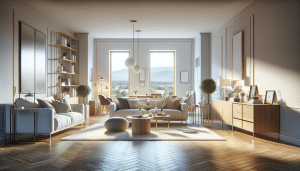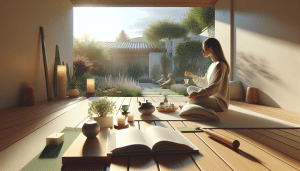Easy Home Organization Hacks You Might Love
Jessica White October 16, 2025
Explore simple yet creative home organization hacks to transform daily spaces. This guide covers practical storage ideas, clever decluttering strategies, and fun ways to make your home function better, all grounded in research-backed methods for a more comfortable lifestyle.
Discovering the Benefits of Home Organization
Home organization isn’t just about keeping rooms tidy; it’s strongly connected to overall well-being and productivity. Studies indicate that a clutter-free environment can boost mental clarity and even improve relaxation at home. It’s about creating a space that supports your routine and personal goals, turning daily chaos into calm. From kitchen drawers to living room shelves, even minor changes can have a lasting impact on comfort. Organization is more than just stacking or hiding items. It’s an intentional effort to bring harmony and enjoyment to personal surroundings, and many people find their mood and focus improve with simple home adjustments (source: https://www.apa.org/news/press/releases/2018/03/homes-clutter).
Many don’t realize how much clutter can influence stress levels. When visual distractions accumulate—on countertops, desks, or closets—they silently wear away at patience and energy. Organized living makes routines easier; finding keys or pantry items no longer means minutes of searching. Spaces designed for efficiency can even reduce arguments or frustration among household members. Research points to a direct connection between home space management and emotional wellbeing, especially in active families or shared living situations. Tidy areas serve as a backdrop for more meaningful activities, allowing people to focus on what matters rather than ongoing messes (source: https://www.ncbi.nlm.nih.gov/pmc/articles/PMC4924172/).
Organization hacks are approachable for everyone, regardless of budget or space size. Simple changes, like adding drawer dividers or multi-purpose baskets, can transform both aesthetic and function. Many individuals embrace home organization not to achieve perfection but to encourage positive habits. There’s a sense of accomplishment after sorting a closet or devising a system for mail and paperwork. These small wins motivate other improvements, turning daunting projects into sustainable routines. By focusing on practical, actionable steps—not just tidiness as a visual goal—home organization becomes realistic and deeply rewarding.
Clever Decluttering Techniques That Actually Work
Getting started with decluttering can feel overwhelming, but methods like the “one-in, one-out” rule offer manageable ways to keep things in balance. This approach suggests that for every new item brought into a space, an older one should be donated, recycled, or repurposed. It works well for clothing, kitchen gadgets, or even children’s toys. Applying such strategies gradually—starting with a single drawer or shelf—makes the process less daunting. Over time, decluttering in small increments often delivers surprising results, leading to a lighter and more welcoming atmosphere (source: https://www.niehs.nih.gov/research/programs/geh/geh_newsletter/2019/7/spotlight-organizing/index.cfm).
Some prefer the “zone” method, dividing rooms into clear function areas—like a reading nook, play space, or work desk. Each section gets its specific purpose and storage system, preventing similar items from scattering across the house. Labeling bins, baskets, and even pantry jars ensures everyone knows where things belong. This method not only improves tidiness but also teaches kids about order and responsibility. Families often customize their zones over time, adapting to evolving needs without losing the momentum of early organizing successes.
Decluttering isn’t about minimizing to the bare minimum. Sometimes, it’s about finding easier ways to store meaningful collections, such as photo albums, documents, or memorabilia. Using vertical wall space, under-bed totes, or furniture with built-in storage lets favorite items stay accessible but contained. There’s a balance—preserving what matters while letting go of what no longer serves a purpose. Many find that sentimental items are easier to enjoy when not lost among excess. Personalized declutter plans help keep the focus on happiness and function instead of rigid rules.
Smart Storage Solutions for Any Room
Small apartments, shared homes, and even larger houses benefit from creative storage ideas. Sliding organizers under sinks, beds, or couches maximize areas that might otherwise go unused. Wall hooks provide instant homes for coats, totes, and hats while freeing up closet bars. Open shelving in kitchens can keep everyday dishes in view, making cooking routines quicker. These solutions are all about making the most of available space and making organization automatic rather than a chore. Items placed where they’re needed save both time and frustration (source: https://www.extension.harvard.edu/inside-extension/home-organization-benefits).
Multi-purpose furniture is also a favorite among organization enthusiasts. Ottomans, benches, or beds with concealed compartments can hide extra linens, shoes, or remotes out of sight yet within reach. Modular storage cubes can be stacked or rearranged to suit evolving needs, and clear bins let users quickly spot what’s inside without endless searching. These options work in bedrooms, offices, playrooms, and living rooms alike, making them versatile solutions. Some individuals enjoy mixing closed and open storage to balance easy access and visual calm, resulting in a space that’s both practical and visually pleasing.
Entryways often present a unique challenge, but even small nooks by the door become landing strips for shoes, bags, and mail with the right strategy. Wall-mounted racks, slim cubbies, and narrow benches keep the area functional without crowding walkways. Many find that starting with this high-traffic spot can set the tone for the whole home, reinforcing good habits every time someone enters. There’s a satisfaction in coming home to an organized space—each item with a purpose and every zone working together harmoniously.
Making Organization Fun for the Whole Family
Organization doesn’t have to feel like a chore when approached with a playful mindset. Involving children in the process transforms tidying into a game, whether it’s timed “race-the-clock” cleanups or color-coded storage bins. Communities and parenting experts recommend assigning tasks by age and interest, building responsibility and confidence in younger family members. Organization becomes a team effort—everyone pitching in to maintain a household flow that feels natural (source: https://www.childwelfare.gov/pubPDFs/organize.pdf).
Teens and adults can personalize their own spaces, experimenting with décor and systems that genuinely work for their habits. Some favor vertical wall grids to pin reminders or display hobbies. Others get creative with repurposing containers, turning jars and boxes into customized holders for everything from toiletries to office supplies. Allowing input from each household member encourages cooperation instead of resistance. Shared accomplishments can be celebrated—such as a tidy game closet or a newly organized craft corner.
Regular “reset” times keep clutter from building up and make maintenance second nature. For some, Sunday afternoons serve as a designated reset, while others prefer short nightly sweeps. Visual progress, like freshly cleared tables or color-coordinated bins, can be surprisingly motivating. Families often discover that once everyone sees the benefits of an organized living space, enthusiasm grows naturally. The key is finding systems that are flexible, enjoyable, and realistic for everyone’s unique rhythms.
Design Meets Function: Stylish Organizing Ideas
There’s no need to sacrifice beauty for practicality. Design-minded organization solutions allow homeowners to combine aesthetics with storage power. Wicker baskets, fabric bins, or chic glass jars add texture and personality to shelves. Matching sets or color-coordinated organizers create a cohesive look, while still serving a crucial role in keeping things sorted. Small stylistic touches—like brass labels or painted wooden boxes—can subtly enhance any space while making it easier to stay organized (source: https://www.houzz.com/magazine/storage-ideas).
Minimalist design trends have also popularized multifunctional décor, such as floating wall shelves adorned with favorite books or plants. Using furnishings that double as organizers means less visual clutter and more harmony in the overall flow of each room. Displaying collections, such as pottery or artwork, within dedicated zones allows for admiration without feeling crowded. The idea is to integrate organizing into the backdrop of each room, letting style and convenience coexist effortlessly.
Sustainable materials are a growing trend within home organization. Bamboo bins, recycled plastics, and repurposed vintage boxes provide eco-friendly options that still offer plenty of strength and charm. Many design-conscious individuals love the look and feel of incorporating natural elements into their storage solutions—it’s a small daily reminder that organization and environmental mindfulness work hand in hand. Easy access, visual appeal, and an eco-forward approach help make organization a lasting habit.
Building Organization Habits That Last
Habits form the foundation of an organized home. Small daily actions—like making the bed, sorting the mail, or emptying the dishwasher promptly—can prevent disarray before it becomes overwhelming. Experts recommend linking organizing tasks to existing routines for better consistency. For example, spending a few minutes after dinner to clear the kitchen or assigning a five-minute tidy during TV commercial breaks makes the process less intimidating. Over time, these small steps add up, gradually shifting the space and mindset toward lasting order (source: https://www.cdc.gov/healthyhomes/bytopic/organization.html).
Consistency is easier when systems are manageable and truly serve your lifestyle. It helps to reevaluate storage and organizing strategies every few months—donating, recycling, or repurposing what no longer fits. Many find value in “the ten-minute tidy,” a quick daily sweep to keep clutter in check. Written checklists, visual cues, or simple reminders on the fridge help reinforce good habits. Progress is more sustainable when it’s acknowledged and celebrated, even in small ways.
The process of maintaining order extends beyond possessions. Digital clutter—including messy desktops or overflowing email inboxes—also impacts well-being. Setting aside time to clear digital spaces is just as important as physical cleanup. This broader approach encourages a holistic sense of organization, one that shapes not just rooms but also daily focus and peace of mind. Embracing home organization as an evolving habit supports a thriving, enjoyable lifestyle that adapts to personal needs and growth.
References
1. American Psychological Association. (2018). Homes and Clutter: How They Impact Well-Being. Retrieved from https://www.apa.org/news/press/releases/2018/03/homes-clutter
2. National Institutes of Health. (2016). The Effects of Clutter on Mental Health. Retrieved from https://www.ncbi.nlm.nih.gov/pmc/articles/PMC4924172/
3. National Institute of Environmental Health Sciences. (2019). Organizing Your Home. Retrieved from https://www.niehs.nih.gov/research/programs/geh/geh_newsletter/2019/7/spotlight-organizing/index.cfm
4. Harvard Extension School. (2023). Organization Benefits at Home. Retrieved from https://www.extension.harvard.edu/inside-extension/home-organization-benefits
5. Child Welfare Information Gateway. (2022). Organizing with Kids. Retrieved from https://www.childwelfare.gov/pubPDFs/organize.pdf
6. Centers for Disease Control and Prevention. (2021). Organization in Healthy Homes. Retrieved from https://www.cdc.gov/healthyhomes/bytopic/organization.html








